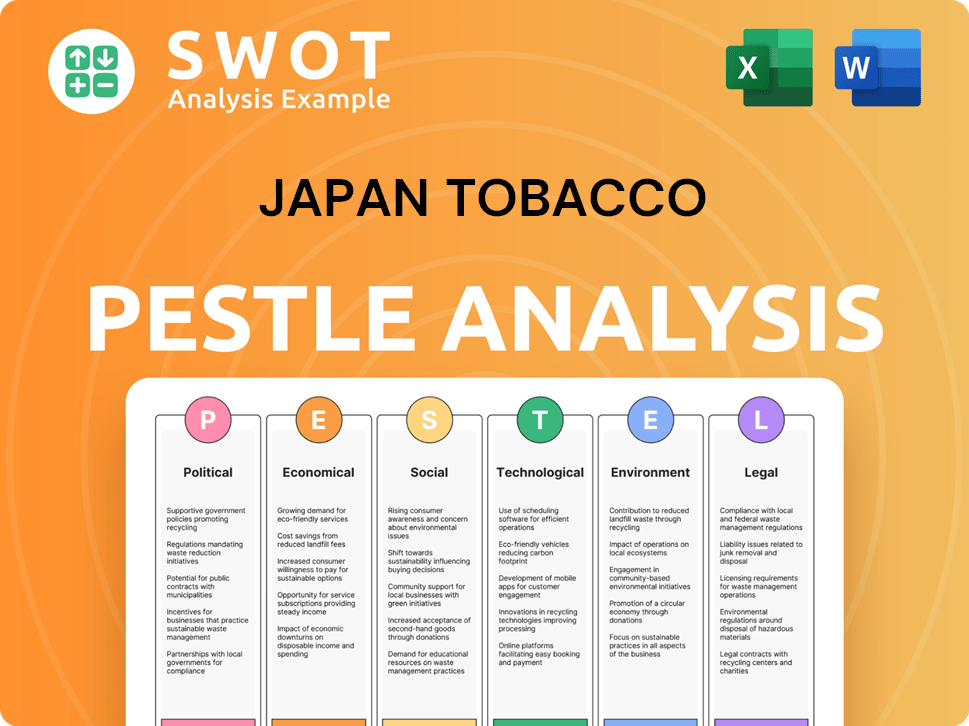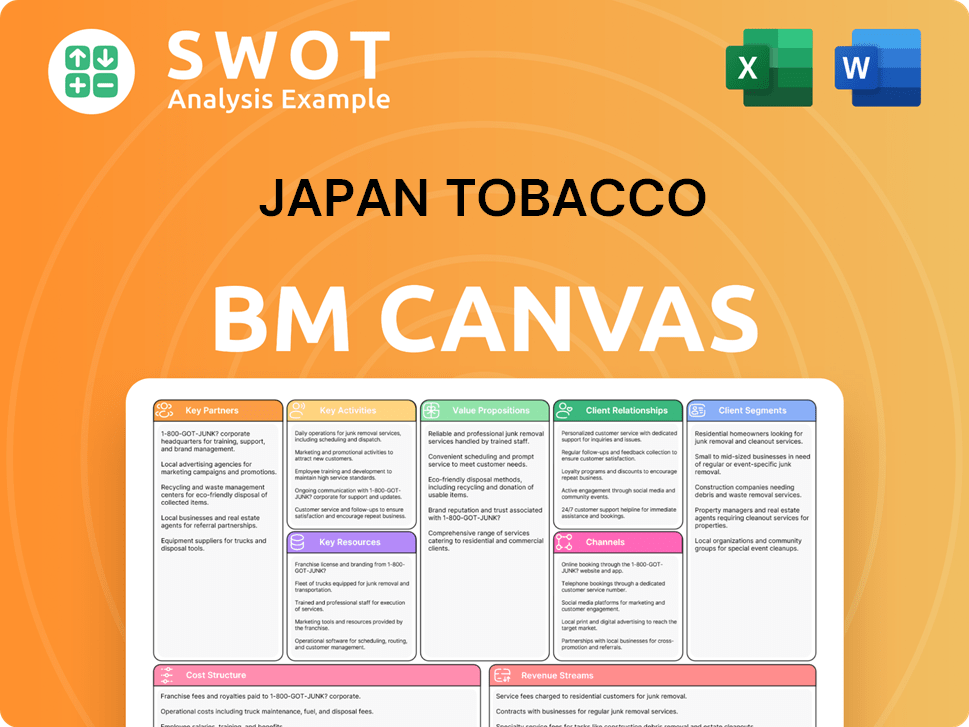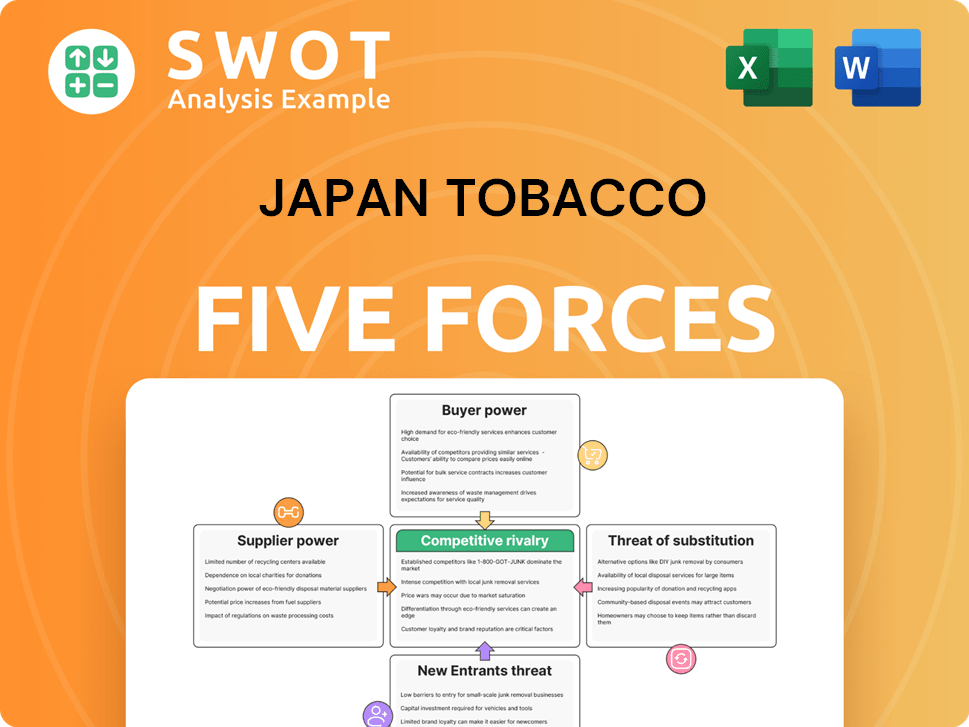Japan Tobacco Bundle
Who Really Owns Japan Tobacco Company?
Unraveling the ownership structure of Japan Tobacco Company is key to understanding its global influence and strategic direction. From its roots as a government monopoly to its current status as a publicly traded entity, the evolution of Japan Tobacco's ownership is a fascinating story. This exploration delves into the key players and their impact on this international tobacco giant.

Understanding Japan Tobacco SWOT Analysis is crucial, as the company, also known as JT, has a complex ownership structure. Discovering who owns Japan Tobacco, including its major shareholders and the role of the Japanese government, provides valuable insights for anyone interested in JT stock. This analysis will also touch upon Japan Tobacco Company's history, its subsidiaries, and how to buy Japan Tobacco stock.
Who Founded Japan Tobacco?
The story of the Japan Tobacco Company (JTC) begins with its roots firmly planted in the Japanese government. Initially, the company operated as a complete state monopoly, directly controlled by the Japanese Ministry of Finance. This structure laid the groundwork for what would become a global tobacco giant.
The Imperial Japanese Tobacco Company was established in 1898 by the Japanese government. The primary goal was to secure tax revenue from tobacco sales. This initial move marked the government's entry into the tobacco business, setting the stage for future developments.
By 1904, the government's control expanded to encompass all aspects of the tobacco industry within Japan. This included the manufacturing of tobacco products. This comprehensive monopoly remained in place for several decades, shaping the company's early operations and market dominance.
The Japan Tobacco and Salt Public Corporation (Nippon Senbai Kōsha) was created in 1949, continuing the state monopoly. This entity managed the tobacco business until significant changes occurred later.
In 1985, Japan Tobacco Inc. was formed as a publicly traded company. This transition was a significant step towards privatization, though the government retained a controlling stake initially.
At its inception, the Japanese government was required to hold at least 50% of the shares. This ensured continued government influence and control over the company's direction.
The government began selling shares to the public in October 1994. This gradual privatization process allowed the public to invest in the company.
The process of selling shares to the public continued over time, reducing the government's stake. This has led to the current ownership structure of the company.
1898: Imperial Japanese Tobacco Company founded. 1904: Government monopoly expands. 1949: Japan Tobacco and Salt Public Corporation established. 1985: Japan Tobacco Inc. formed. 1994: Initial public offering begins.
The transformation of the Japan Tobacco Company from a government monopoly to a publicly traded entity was a gradual process. The government's initial control ensured a stable transition, while the subsequent sale of shares to the public allowed for broader investment. Today, understanding the history of Japan Tobacco ownership provides insight into the company's evolution and its current position in the global market. For more details on Japan Tobacco Company, you can find more information about the company's history.
The company's origins are rooted in the Japanese government's desire to control the tobacco market and generate revenue.
- The Imperial Japanese Tobacco Company was established in 1898.
- The government's monopoly expanded by 1904.
- Japan Tobacco Inc. was formed in 1985 as a publicly traded company.
- The Japanese government initially held at least 50% of the shares.
- Share sales to the public began in October 1994.
Japan Tobacco SWOT Analysis
- Complete SWOT Breakdown
- Fully Customizable
- Editable in Excel & Word
- Professional Formatting
- Investor-Ready Format

How Has Japan Tobacco’s Ownership Changed Over Time?
The ownership structure of the Japan Tobacco Company has evolved significantly since its privatization in 1985. Initially, the Japanese government held a dominant position. Over time, while the company became publicly traded, the government has maintained a considerable stake, shaping the company's governance and strategic direction. Understanding the shifts in ownership provides insights into the company's financial performance and market strategies. For more information on how the company approaches its market, consider reading about the Marketing Strategy of Japan Tobacco.
The Japanese government's stake in Japan Tobacco has fluctuated over the years. In June 2003, the Japanese Ministry of Finance held two-thirds of the company. This was reduced to 50% by March 2013. In May 2012, the government announced plans to sell one-sixth of the outstanding shares to generate ¥500 billion for reconstruction efforts following the 2011 earthquake and tsunami, with the sale completed in March 2013. These changes in major shareholding directly impact the company's governance.
| Shareholder | Percentage of Shares (as of March 31, 2025) | Notes |
|---|---|---|
| Minister of Finance | 37.56% | Largest shareholder, mandated by the JT Act. |
| Master Trust Bank of Japan, Ltd. (Trust Account) | 9.76% | Significant institutional investor. |
| Custody Bank of Japan, Ltd. (Trust Account) | 2.92% | Another key institutional investor. |
| STATE STREET BANK WEST CLIENT - TREATY 505234 | 1.48% | Notable institutional investor. |
| STATE STREET BANK AND TRUST COMPANY 505001 | 1.00% | Significant institutional investor. |
| JP MORGAN CHASE BANK 385781 | 0.87% | Institutional investor. |
| JT Group Employee Shareholding Association | 0.65% | Employee ownership. |
As of March 31, 2025, the Minister of Finance remains the largest shareholder, holding 37.56% of all issued shares. This governmental ownership is mandated by the JT Act, which requires the government to continuously hold more than one-third of the company's total issued shares. Other major institutional investors also hold significant portions of shares, including the Master Trust Bank of Japan, Ltd. (Trust Account) with 9.76%, and Custody Bank of Japan, Ltd. (Trust Account) with 2.92%. These shareholders, along with others like STATE STREET BANK and JP MORGAN CHASE BANK, influence the company's strategic decisions and financial performance, making it crucial for investors to understand the Japan Tobacco ownership structure.
The Japanese government's significant stake in Japan Tobacco provides substantial influence over company decisions.
- The government's ownership gives it influence over ordinary resolutions.
- The government holds veto power over special resolutions, such as mergers.
- Institutional investors also play a crucial role in the company's ownership.
- Understanding the shareholder structure is vital for assessing the company's governance.
Japan Tobacco PESTLE Analysis
- Covers All 6 PESTLE Categories
- No Research Needed – Save Hours of Work
- Built by Experts, Trusted by Consultants
- Instant Download, Ready to Use
- 100% Editable, Fully Customizable

Who Sits on Japan Tobacco’s Board?
The Board of Directors of the Japan Tobacco Company (JTC) operates under a governance structure heavily influenced by the Japanese government's significant ownership. While specific details on individual board members representing major shareholders as of mid-2025 are not readily available, the government's mandated holding of over one-third of all issued shares as of March 31, 2025, at 37.56%, grants it considerable influence. This ensures the Japanese government has a substantial say in proposals for ordinary resolutions at General Meetings of Shareholders, including the election of Members of the Board. The government's role is crucial in shaping the company's strategic direction and operational decisions.
The voting structure generally follows a one-share-one-vote principle; however, the government's statutory ownership acts as a 'golden share' equivalent, providing it with outsized control. This is further reinforced by the Minister of Finance's authority to supervise the company under the JT Act and Tobacco Business Act. This supervisory power extends to requiring the Minister of Finance's approval for Japan Tobacco to engage in new businesses outside its currently approved scope. The potential for the government's interests not always aligning with other shareholders can negatively affect the interests of those other shareholders. For further insights into the company's origins, you can read more in the Brief History of Japan Tobacco.
| Aspect | Details | Impact |
|---|---|---|
| Government Ownership | 37.56% of shares as of March 31, 2025. | Significant influence on board decisions and strategic direction. |
| Voting Rights | One-share-one-vote, but government stake provides substantial control. | Government can effectively control key decisions. |
| Regulatory Oversight | Minister of Finance supervises the company. | Ensures alignment with government interests and approval for new business ventures. |
The Japanese government's ownership significantly shapes the company's governance.
- Government holds a substantial stake, influencing board decisions.
- The voting structure gives the government considerable control.
- Regulatory oversight by the Minister of Finance further reinforces government influence.
- This structure can impact the interests of other shareholders.
Japan Tobacco Business Model Canvas
- Complete 9-Block Business Model Canvas
- Effortlessly Communicate Your Business Strategy
- Investor-Ready BMC Format
- 100% Editable and Customizable
- Clear and Structured Layout

What Recent Changes Have Shaped Japan Tobacco’s Ownership Landscape?
In recent years, Japan Tobacco Company (JTC) has seen significant shifts in its ownership and strategic direction. A key move was the acquisition of Vector Group Ltd. (VGR) on October 7, 2024, for $2.4 billion, which is now a wholly-owned subsidiary. This acquisition is projected to increase JT's U.S. market share to 8% and bolster its distribution network, leading to a positive impact on earnings per share, starting in 2025.
Another major development is the planned transfer of its Pharmaceutical Business to Shionogi & Co., Ltd., expected to conclude in the second half of 2025. This strategic shift highlights JT's focus on its core tobacco business, particularly reduced-risk products (RRPs). JT Group intends to invest ¥450 billion (approximately $3 billion USD) in RRPs by the end of 2026, aiming to expand its heated tobacco product 'Ploom' into around 45 markets by 2026. Furthermore, JT is exploring manufacturing 'Ploom' devices in the United States and plans a joint venture with Altria for a potential 2027 launch in the US market.
| Metric | Value | Year |
|---|---|---|
| Vector Group Ltd. Acquisition Cost | $2.4 billion | 2024 |
| JT's U.S. Market Share (Post-Acquisition) | 8% | 2025 (Projected) |
| RRP Investment Target | ¥450 billion (approx. $3 billion USD) | By the end of 2026 |
| Government Ownership (Minister of Finance) | 37.56% | March 31, 2025 |
Regarding share buybacks, Japan Tobacco Inc. reported common stock repurchases of USD -12.72 thousand for the year ending December 31, 2024, a 79.48% change year over year. The Japanese government's ownership remains substantial, with the Minister of Finance holding 37.56% of the shares as of March 31, 2025. This significant governmental stake impacts the company's strategic autonomy. The company continues to focus on global expansion in tobacco and RRPs through acquisitions and investments.
The company's financial performance reflects its strategic moves. Investors interested in JT stock should monitor these developments closely. The acquisition of Vector Group and the focus on RRPs are key factors to watch for.
The Japanese government remains a major shareholder, influencing the company's direction. Other Japan Tobacco shareholders include institutional investors. Understanding the ownership structure is key to analyzing JT's strategy.
The government's significant stake in Japan Tobacco Company provides stability. The company's focus on RRPs aligns with evolving market trends. This ownership structure affects the company's strategic decisions.
The Japanese government holds a large percentage of shares. Institutional investors also play a role. Understanding these shareholders provides insights into the company's direction.
Japan Tobacco Porter's Five Forces Analysis
- Covers All 5 Competitive Forces in Detail
- Structured for Consultants, Students, and Founders
- 100% Editable in Microsoft Word & Excel
- Instant Digital Download – Use Immediately
- Compatible with Mac & PC – Fully Unlocked

Related Blogs
- What are Mission Vision & Core Values of Japan Tobacco Company?
- What is Competitive Landscape of Japan Tobacco Company?
- What is Growth Strategy and Future Prospects of Japan Tobacco Company?
- How Does Japan Tobacco Company Work?
- What is Sales and Marketing Strategy of Japan Tobacco Company?
- What is Brief History of Japan Tobacco Company?
- What is Customer Demographics and Target Market of Japan Tobacco Company?
Disclaimer
All information, articles, and product details provided on this website are for general informational and educational purposes only. We do not claim any ownership over, nor do we intend to infringe upon, any trademarks, copyrights, logos, brand names, or other intellectual property mentioned or depicted on this site. Such intellectual property remains the property of its respective owners, and any references here are made solely for identification or informational purposes, without implying any affiliation, endorsement, or partnership.
We make no representations or warranties, express or implied, regarding the accuracy, completeness, or suitability of any content or products presented. Nothing on this website should be construed as legal, tax, investment, financial, medical, or other professional advice. In addition, no part of this site—including articles or product references—constitutes a solicitation, recommendation, endorsement, advertisement, or offer to buy or sell any securities, franchises, or other financial instruments, particularly in jurisdictions where such activity would be unlawful.
All content is of a general nature and may not address the specific circumstances of any individual or entity. It is not a substitute for professional advice or services. Any actions you take based on the information provided here are strictly at your own risk. You accept full responsibility for any decisions or outcomes arising from your use of this website and agree to release us from any liability in connection with your use of, or reliance upon, the content or products found herein.